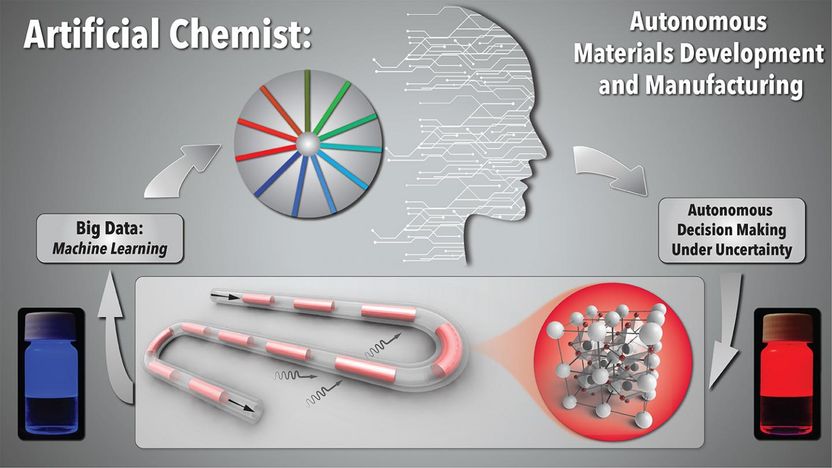'Artificial chemist' combines AI, robotics to conduct autonomous R&D
Fully autonomous materials development and manufacturing
Researchers from North Carolina State University and the University at Buffalo have developed a technology called "Artificial Chemist," which incorporates artificial intelligence (AI) and an automated system for performing chemical reactions to accelerate R&D and manufacturing of commercially desirable materials.

Researchers have developed a technology called "Artificial Chemist," which incorporates AI and an automated system for performing chemical reactions to accelerate R&D and manufacturing of commercially desirable materials.
Milad Abolhasani
In proof-of-concept experiments, the researchers demonstrated that Artificial Chemist can identify and produce the best possible quantum dots for any color in 15 minutes or less. Quantum dots are colloidal semiconductor nanocrystals, which are used in applications such as LED displays.
However, the researchers are quick to note that Artificial Chemist can identify the best material to meet any suite of measurable properties - not just quantum dots.
"Artificial Chemist is a truly autonomous system that can intelligently navigate through the chemical universe," says Milad Abolhasani, corresponding author of a paper on the work and an assistant professor of chemical and biomolecular engineering at NC State. "Currently, Artificial Chemist is designed for solution-processed materials - meaning it works for materials that can be made using liquid chemical precursors. Solution-processed materials include high-value materials such as quantum dots, metal/metal oxide nanoparticles, metal organic frameworks (MOFs), and so on.
"The Artificial Chemist is similar to a self-driving car, but a self-driving car at least has a finite number of routes to choose from in order to reach its pre-selected destination. With Artificial Chemist, you give it a set of desired parameters, which are the properties you want the final material to have. Artificial Chemist has to figure out everything else, such as what the chemical precursors will be and what the synthetic route will be, while minimizing the consumption of those chemical precursors.
"The end result is a fully autonomous materials development technology that not only helps you find the ideal solution-processed material more quickly than any techniques currently in use, but it does so using tiny amounts of chemical precursors. That significantly reduces waste and makes the materials development process much less expensive."
The Artificial Chemist has both a "body" for performing experiments and sensing the experimental results, and a "brain" for recording that data and using it to determine what the next experiment will be.
For their proof-of-concept testing, Artificial Chemist's body incorporated the automated Nanocrystal Factory and NanoRobo flow synthesis platforms developed in Abolhasani's lab. The Artificial Chemist platform has demonstrated that it can run 500 quantum dot synthesis experiments per day, though Abolhasani estimates it could run as many as 1,000.
The Artificial Chemist's brain is an AI program that characterizes the materials being synthesized by the body and uses that data to make autonomous decisions about what the next set of experimental conditions will be. It bases its decisions on what it determines will most efficiently move it toward the best material composition with the desired properties and performance metrics.
"We tried to mimic the process that humans use when making decisions, but more efficiently," Abolhasani says.
For example, Artificial Chemist allows "knowledge transfer," meaning that it stores data generated from every request it receives, expediting the process of identifying the next candidate material it is tasked with. In other words, Artificial Chemist gets smarter and faster over time at identifying the right material.
For their proof of concept, the researchers tested nine different policies for how the AI uses data to decide what the next experiment will be. They then ran a series of requests, each time asking Artificial Chemist to identify a quantum dot material that was the best fit for three different output parameters.
"We found a policy that, even without prior knowledge, could identify the best quantum dot possible within 25 experiments, or about one-and-a-half hours," Abolhasani says. "But once Artificial Chemist had prior knowledge - meaning that it had already handled one or more target material requests - it could identify the optimal material for new properties in 10 to 15 minutes.
"We found that Artificial Chemist could also rapidly identify the boundaries of materials properties for a given set of starting chemical precursors, so that chemists and materials scientists do not need to waste their time on exploring different synthesis conditions.
"I believe autonomous materials R&D enabled by Artificial Chemist can re-shape the future of materials development and manufacturing," Abolhasani says. "I'm now looking for partners to help us transfer the technique from the lab to the industrial sector."






























































